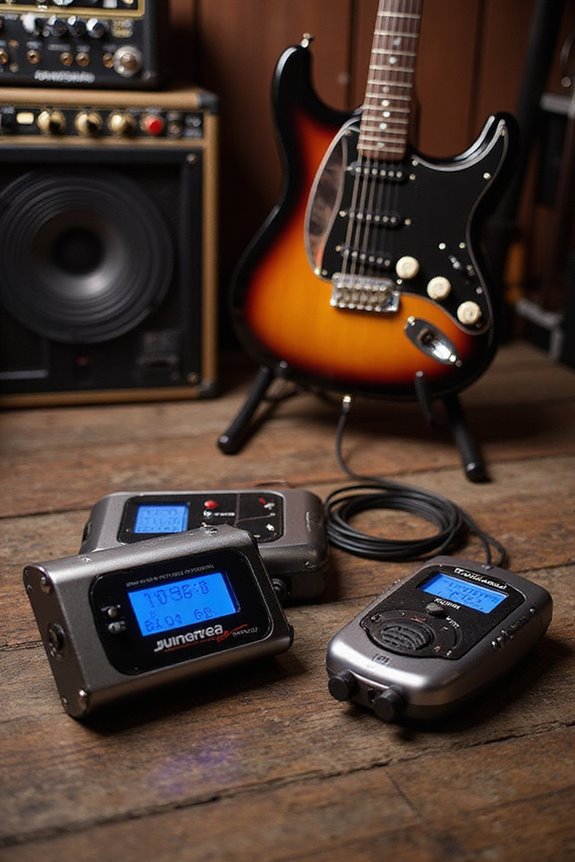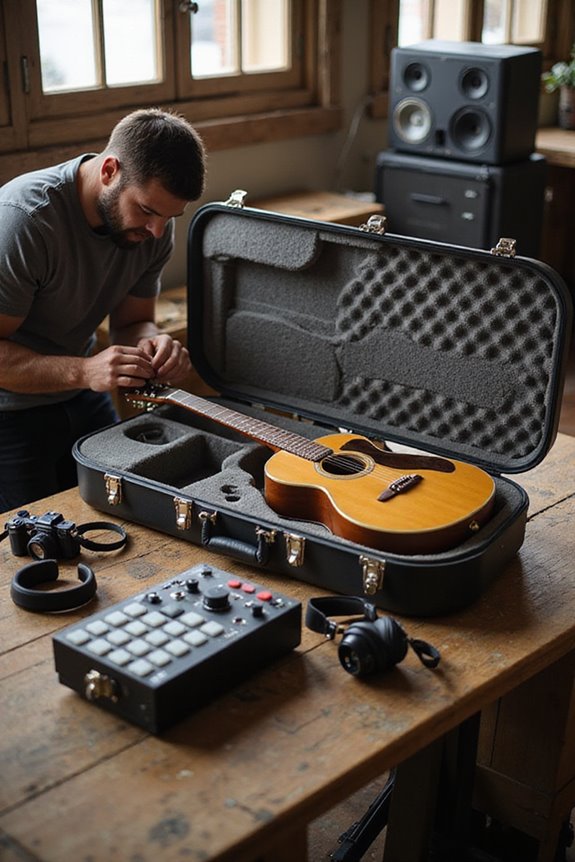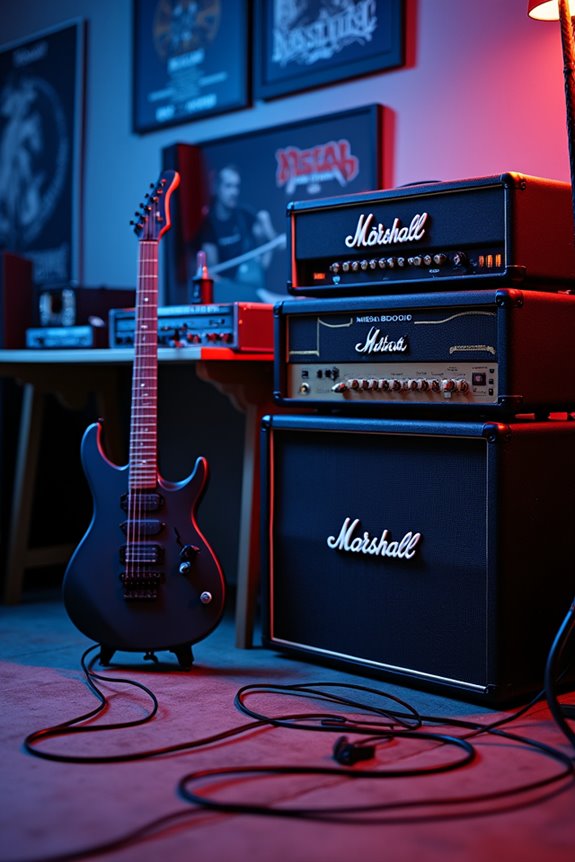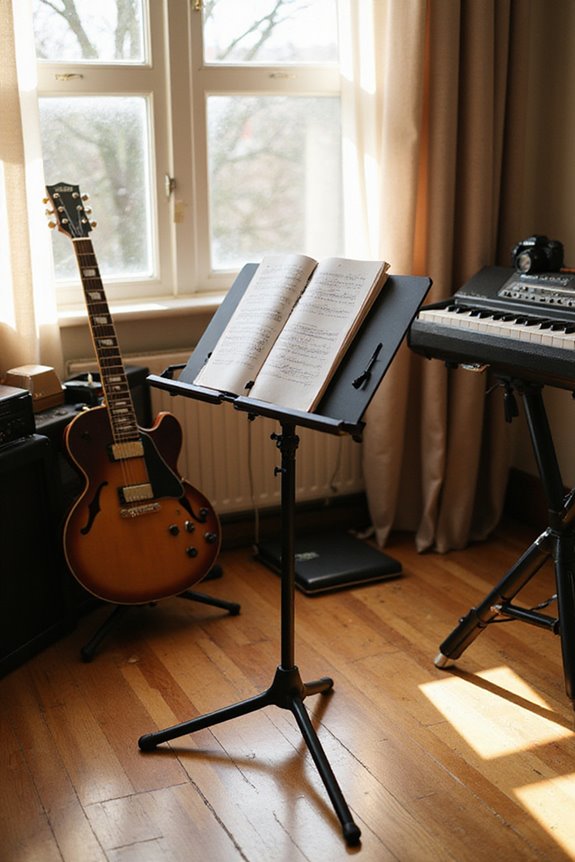When we’re looking for the best wireless guitar systems for live shows, we should consider a few key features. Systems like the Line 6 Relay G10S stand out for their range of up to 130 feet and robust signal quality. For budget-conscious musicians, the XVive A58 offers impressive performance at a lower price. If we’re just starting out, the Fender Telepath simplifies setup with its auto-pairing. Each option has strengths that cater to different playing styles, and there’s more to explore.
Key Takeaways
- The Shure GLX-D16 offers an impressive 200-foot range and dual-band technology for interference-free transmission during live performances.
- Line 6 Relay G10S provides 24-bit digital audio quality with a robust range of 130 feet, ideal for stage mobility.
- XVive A58 is a reliable budget option, operating on a 5.8 GHz band for clear signals and a 100-foot range.
- Fender Telepath is beginner-friendly with auto-pairing technology, compact design, and up to 70 feet of transmission range for versatile performances.
- Prioritize systems with long battery life (7 hours+) and simple setup to minimize interruptions during live shows.
Top Features to Look for in Wireless Guitar Systems
When we’re on the hunt for the best wireless guitar systems, it’s vital to know what features will genuinely enhance our playing experience. First and foremost, we should prioritize signal clarity. Look for systems that boast a high signal-to-noise ratio of 100dB or more, ensuring minimal background noise during our performances. Additionally, an effective range of at least 70 feet can provide us the freedom to move without losing connection. We also want to take into account the frequency response; a range of 20Hz–20kHz captures the full spectrum of our guitar tones. Low-latency options, ideally under 5ms, will keep our playing in sync during live shows, making these features essential when selecting a reliable wireless system.
Best Overall Performance: Line 6 Relay G10S
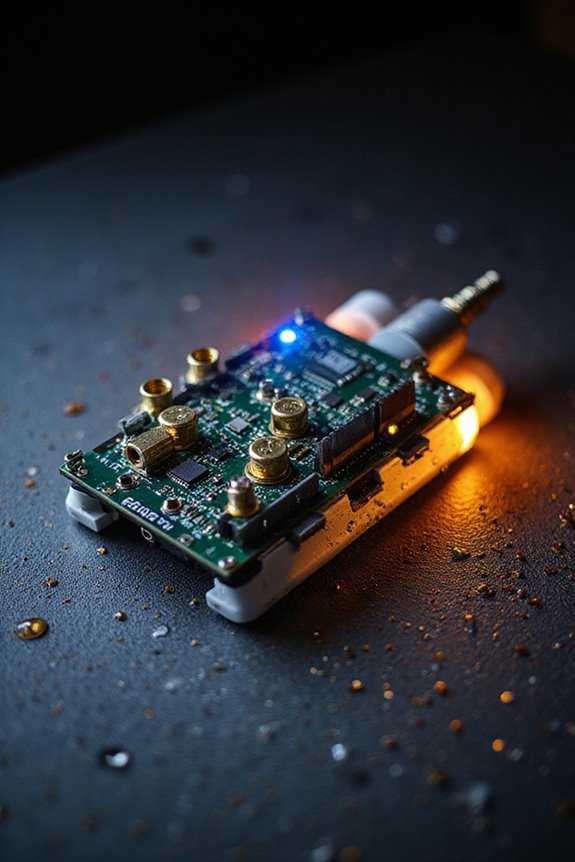
For guitarists seeking reliable performance without the hassle of tangled cables, the Line 6 Relay G10S stands out as an exceptional choice. This system showcases impressive wireless advantages, including pristine 24-bit digital transmission that guarantees lossless sound quality during live shows. With a robust range of up to 130 feet, we can move freely on stage without worrying about dropouts. The compact, rugged design integrates seamlessly into our pedalboards, making setup a breeze. Plus, the automatic frequency scanning simplifies our experience, allowing us to focus on our performance. With a rechargeable transmitter offering up to 8 hours of playtime, the G10S is built for professional use, assuring that we can deliver our best sound night after night.
Best Budget Options: XVive A58 and XVive U2
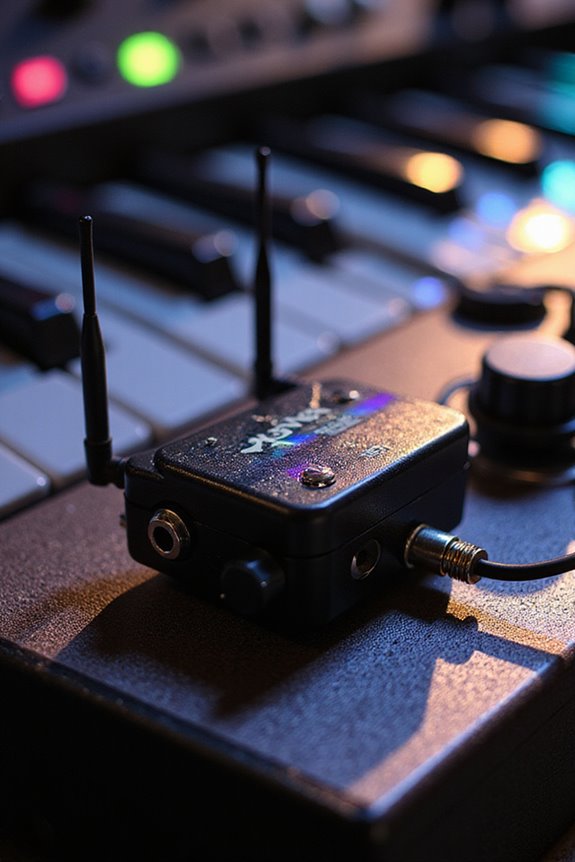
Finding the right wireless guitar system on a budget can be challenging, but the XVive A58 and U2 offer fantastic options that don’t skimp on quality. When we consider budget considerations, the A58 shines with its 5.8 GHz frequency, providing clearer signals and an impressive range of 100 feet. In our performance comparison, it outperforms the U2, which operates on a congested 2.4 GHz band and has a shorter range of 70 feet. The A58 also features automatic channel scanning, ensuring a stable connection during gigs. While both systems deliver 24-bit audio with low latency, the A58’s reliability makes it a top pick for live performances. For budget-conscious musicians, these systems deliver essential quality without breaking the bank.
Best for Beginners: Fender Telepath
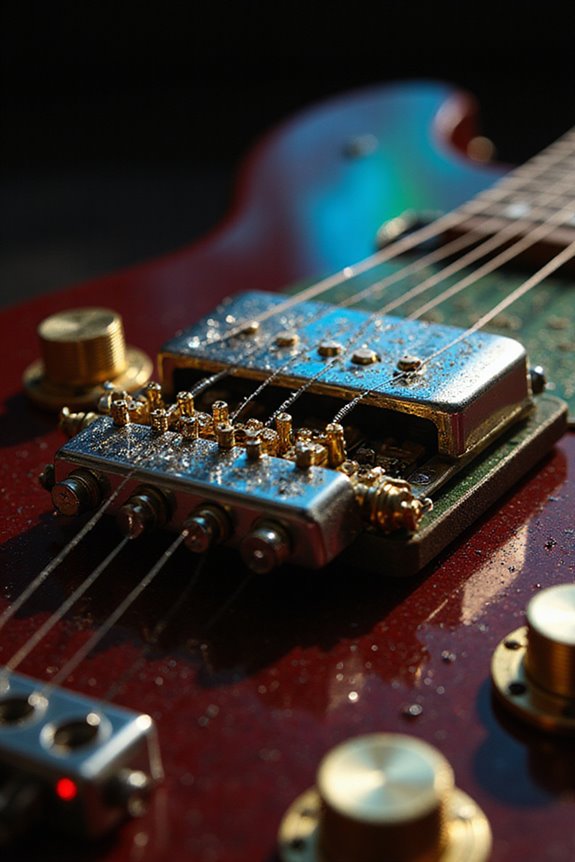
As we step into the world of wireless guitar systems, the Fender Telepath stands out as an excellent choice for beginners. Its beginner-friendly features include auto-pairing technology, making setup a breeze—just link the transmitter and receiver in seconds. With a transmission range of up to 70 feet, we can roam freely during performances without worrying about dropouts.
The compact design and lightweight build make it easy to transport, while the rechargeable battery offers up to 8 hours of use. For wireless setup tips, remember to check the battery status before gigs and utilize the active/passive switch to accommodate different instruments. Overall, the Fender Telepath is an ideal choice for those just starting their musical journey.
Best for Live Performances: Shure GLX-D16
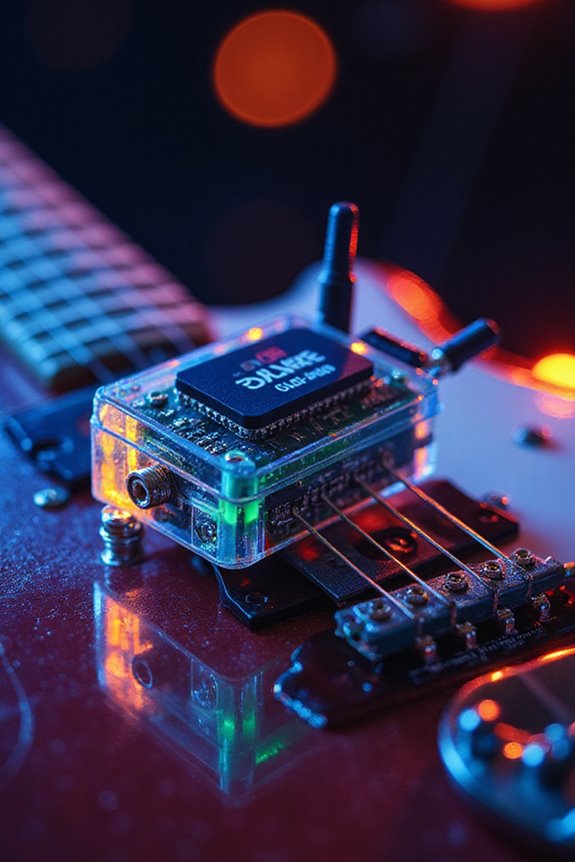
When it comes to live performances, the Shure GLX-D16 wireless system truly excels, providing guitarists and bass players with a reliable and high-quality solution. With a wireless range of up to 200 feet under ideal conditions, we can move freely on stage without worrying about dropouts. Its dual band technology scans both 2.4 GHz and 5.8 GHz frequencies, ensuring interference-free transmission and superb audio quality. The system’s frequency response spans 20 Hz to 20 kHz, capturing every nuance of our instrument’s tone. Plus, the integrated tuner and seamless integration with pedalboards make setup a breeze. With up to 12 hours of battery life, we can perform confidently, knowing our sound remains pristine throughout the show.
Best for Pedalboards: Boss WL-50
For musicians who value both portability and performance, the Boss WL-50 wireless guitar system is an ideal choice for pedalboard setups. Its compact, stompbox-size receiver fits seamlessly into our pedalboards without hogging space. The lightweight transmitter plugs directly into our guitar’s output jack, ensuring easy pedal compatibility.
With a stable 2.4 GHz signal, we can enjoy ultra-low latency of just 2.3 milliseconds, giving us a real-time playing feel. Plus, the wireless range extends up to 65 feet, which is perfect for live shows. The receiver even features a cable bypass option in emergencies. Whether we’re using passive or active pickups, the Boss WL-50 enhances our sound while maintaining that essential signal stability we all seek.
Special Features: Positive Grid Spark Link
The Positive Grid Spark Link stands out as a game changer for guitarists seeking versatility and ease of use in their wireless systems. With advanced connectivity options, it operates on 2.4 GHz wireless technology, ensuring a stable signal up to 70 feet away. The compact design makes it easy to integrate into any setup while weighing only 0.1 kg.
We appreciate its impressive audio resolution of 24-bit/48kHz, delivering professional sound quality with minimal latency under 3ms. The adaptive, hinged plug provides a secure connection, making it compatible with various instruments. For live performances or practice sessions, the Spark Link’s six-hour battery life means we can play without interruptions, truly enhancing our musical experience.
Compact and Versatile: NUX B-8
Compact and versatile, the NUX B-8 offers guitarists a robust solution for wireless performance needs. Its compact design guarantees easy portability, making it perfect for gigs of any size. With a maximum operating range of 160 feet, we can roam freely on stage without worrying about signal dropouts.
The automatic pairing system allows for quick setup, and the built-in tuner is a handy feature for guaranteeing our instruments are always performance-ready. Thanks to its ability to connect to electric guitars, basses, and more, we enjoy versatile usage, adapting to any performance scenario. The rechargeable battery provides up to 6.5 hours of continuous use, ensuring we’re always prepared, whether in rehearsal or live shows.
Effective Performance: Blackstar Airwave I58
When we think about effective performance, the Blackstar Airwave I58 stands out as a reliable choice for musicians seeking seamless wireless freedom. One of the key performance benefits is its operation in the 5.8GHz frequency band, which minimizes WiFi interference, ensuring clear sound transmission. With ultralow latency of less than 6 milliseconds, we experience real-time sound without delay, making it perfect for engaging with our audience.
The setup convenience is remarkable, too; the compact transmitter easily attaches to our guitar strap, and the receiver fits right on our pedalboard. Plus, with a transmission range of up to 100 feet, we can move freely on stage. The Blackstar Airwave I58 truly enhances our live performance experience with its reliability and sound quality.
Tips for Choosing the Right Wireless System for Your Needs
Choosing the right wireless guitar system can feel overwhelming, especially with the variety of options available today. To guarantee we pick the best fit, we should consider several factors.
Wireless Transmission and Frequency Selection: Opt for systems in less crowded bands, like 5.8 GHz, to avoid interference, especially in busy venues.
Performance Reliability and Audio Fidelity: Look for low latency (under 6ms) and high dynamic range—this preserves our guitar’s tonal nuances.
Battery Management: Long-lasting batteries (7 hours+) and indicators for battery status are essential.
Setup Simplicity and Ergonomic Design****: Go for compact, plug-and-play systems that streamline our stage setup.
Frequently Asked Questions
How Do I Troubleshoot Connectivity Issues With My Wireless System?
Did you know 30% of wireless systems face signal interference? To troubleshoot, we should check battery life, secure connections, adjust frequencies, and isolate devices to guarantee peak performance and minimize disruptions during use.
Can I Use Multiple Wireless Systems Simultaneously?
Absolutely, we can use multiple wireless systems simultaneously! By ensuring multiple system compatibility and selecting different frequency bands, we effectively reduce wireless interference. This way, we enjoy seamless performances without any interruptions.
What Is the Average Lifespan of a Wireless Guitar System?
When it comes to wireless technology, we’ve got to face the music: the average lifespan of a wireless guitar system typically ranges from three to five years, depending on quality and usage. Let’s choose wisely!
Are Wireless Systems Compatible With All Guitar Brands?
Yes, we’ve found that wireless systems offer excellent wireless compatibility with all guitar brands. They connect via standard jacks, ensuring seamless performance regardless of whether we’re using a Fender, Gibson, or any other brand.
How Do Environmental Factors Affect Wireless Performance?
When it comes to wireless performance, environmental factors can feel like they’re playing a game of hide-and-seek! Signal interference and frequency range issues can drastically affect our sound, so we must be mindful of our surroundings.

